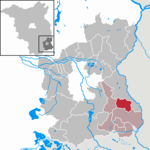Forst (Lausitz)
Divided citiesForst (Lausitz)Germany–Poland border crossingsPages with Lower Sorbian IPAPopulated places in Spree-Neiße ... and 1 more
Towns in Brandenburg

Forst (Lausitz) (German) or Baršć (Łužyca) (Lower Sorbian, pronounced [ˈbarɕtɕ ˈwuʒɨtsa]) is a town in Lower Lusatia, Brandenburg, in eastern Germany. It lies east of Cottbus, on the Lusatian Neisse river which is also the German-Polish border. It is the capital of the Spree-Neiße district. It is known for its rose garden and textile museum. The town's population is 18,651. In Forst, there is a railway bridge across the Neiße belonging to the line Cottbus–Żary which is serviced by regional trains and a EuroCity train between Hamburg and Kraków (2011). There is also a road bridge across the river north of Forst.
Excerpt from the Wikipedia article Forst (Lausitz) (License: CC BY-SA 3.0, Authors, Images).Forst (Lausitz)
Spremberger Straße,
Geographical coordinates (GPS) Address Nearby Places Show on map
Geographical coordinates (GPS)
| Latitude | Longitude |
|---|---|
| N 51.733333333333 ° | E 14.633333333333 ° |
Address
Spremberger Straße
03149 , Siedlung Eigene Scholle - Swójske Grunty
Brandenburg, Germany
Open on Google Maps



